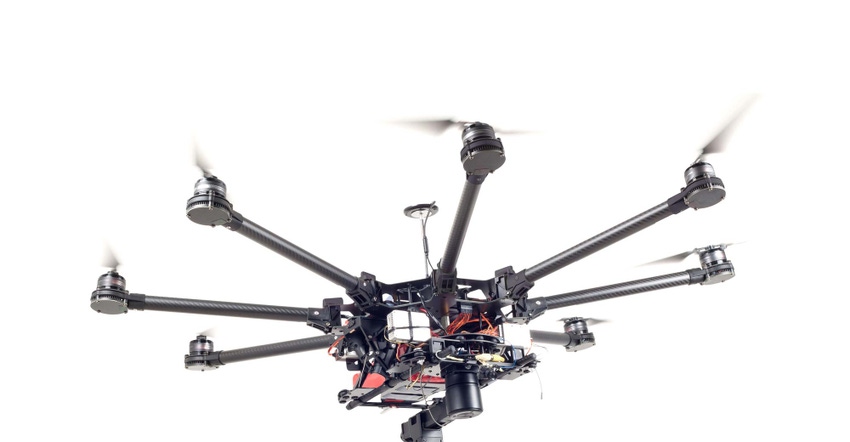At some point in the not-too-distant future, fleets of commercial drones are expected to swarm across American skies.
May 13, 2017

Companies in a wide range of industries will employ unmanned vehicles for tactical advantage—inspecting infrastructure, surveying crops, maybe even estimating how much your new roof will cost.
And when these drones fly, a torrent of data will follow them like an invisible contrail.
“Data is the new oil,” Intel Corp. Chief Executive Officer Brian Krzanich said this week at the Association for Unmanned Vehicle Systems International’s annual Xponential conference in Dallas, the industry’s top trade show. He cited a growing competitive “separation” between companies that collect and understand their data and those that don’t. A single autonomous car can generate the same data trove as 3,000 people surfing the internet, while a small drone fleet could easily create 150 terabytes of data per day, he said (1,000 gigabytes equals 1 terabyte). “The data rate is going to explode on us in the next few years,” Krzanich said.
But how to handle that wide open fire hose of information?
“Operation of an unmanned system is no longer a stand-alone activity,” Lockheed Martin Corp. proclaims in its promotional materials for its Hydra Fusion Tools software. “There [is] an assortment of maps, images, video, and intelligence which are being broadcast to the operators and this needs to be fused into a common operational picture.” This proposition, unsurprisingly, is leading to an array of new business models aimed at helping companies sift through and exploit the mountains of information headed their way.
Into this universe comes Airbus SE, the European aerospace conglomerate. Airbus is starting a new data company, called Airbus Aerial, to provide an array of unmanned aerial vehicles (UAV) services, a field the company estimates could increase to more than $120 billion annually as the use of these fleets expands, said Dirk Hoke, CEO of Airbus’s defence and space group. Hoke introduced the new company Wednesday at Xponential.
The proliferation of commercial drones won’t be so much about getting your pizza or new shirt faster—although there is that consideration—but a broader change in how companies employ aerial surveillance and data to inform their businesses, spurred by efficiency and new U.S. rules allowing commercial unmanned systems to operate at farther distances, autonomously.
A diverse array of companies, ranging from insurers and utilities to real estate and energy, are likely to shift some of their operations to UAV. Some of the work now done by helicopters could be replaced at lower cost. Insurers, for example, are finding aerial surveillance to be a good method for assessing claims after tornadoes and hurricanes and to help understand risks in their underwriting activities.
Airbus Aerial aims to compile high-altitude data from a fleet of eight Airbus satellites and drones, blending it into an intelligence service for agriculture, insurance, oil and gas, utilities, and state and local governments. Aerial will be based in Germany, near Munich, with U.S. offices in Atlanta.
The company sees 2017 as a way to explore the market, testing the business with “a small, select group of customers” to determine how clients will value Aerial’s services, said Jana Rosenmann, Airbus senior vice president of unmanned aerial systems. Airbus will fly third-party drones for its clients but will also explore building its own hardware, she said. “The initial business is not relying on Airbus having its own drone today,” Rosenmann said in a telephone interview.
The company already operates high-altitude solar-powered UAVs, dubbed Zephyr, which has stayed aloft for as long as 14 days. Airbus calls Zephyr “a high-altitude pseudo satellite” due to its high cruising level of up to 70,000 feet.
Most customers will have a specific need for the services of companies like Aerial and won’t care how the information is acquired, be it by drone, satellite, or other means, said Jesse Kallman, who will lead the Airbus unit’s U.S. operations. “A drone is really just a truck that you stick a sensor on,” he said. “We will use whatever hardware makes the most sense.” Aerial pricing is likely to be tailored to a specific market or customer, Kallman said, ranging from recurring subscriptions to one-off jobs.
To date, one of the major impediments to commercial drone flying has been the lack of federal rules, which are now pending at the Federal Aviation Administration. The regulations sort out operational guidelines to� integrate UAVs safely into existing air traffic. Although slow to get these rules squared away, the American UAV service market may mature more quickly than in Europe, owing to the U.S. having only a single regulatory body, Hoke said.
Yet as soon as these new commercial operations take flight, those who employ them will be grappling with “the whole info-glut problem,” said Nazlin Kanji, a program director at AeroVironment Inc., a Simi Valley, Calif.-based defense contractor that builds drones and analytics software for military and civilian use. “It’s an interesting challenge because the amount of data that drones generate is huge—we’re talking petabytes and petabytes of data,” she said (1,000 terabytes equals 1 petabyte). “It really becomes that big data problem everybody keeps talking about but no one really knows how to address.”
The field of drone services has already begun seeing consolidation among smaller players, with much of the business focused on courting large companies and recurring revenue streams, said Jon Damush, vice president of commercial at Insitu, a Boeing Co. subsidiary that builds and flies drones. Over time, given the cost of contracting with a drone service, some of the larger drone data users—such as miners and pipeline operators—might decide to buy their own drones and software. “When you become a certain size on the expense line, somebody’s going to notice,” Damush said.
But Kanji counters that there’s room “for a lot of different vendors,” from companies that offer just data storage to others that may sell analysis, data collection, or a combination. Some of these data wranglers focus on software, offering drone users the ability to create detailed interfaces for the data that UAVs emit.
Others, such as Insitu, focus on drone reconnaissance and data analysis for railroads, large mining companies in Australia, and pipeline operators. That’s the larger-scale end of the business, leaving many smaller players eager to exploit common drone necessities among many industries. “One thing we’ve found is that with agriculture, utilities, railroads, and construction, a lot of them have very similar needs,” Kanji said, citing one example: “All of them worry about vegetation.”
About the Author(s)
You May Also Like
.png?width=700&auto=webp&quality=80&disable=upscale)
.png?width=700&auto=webp&quality=80&disable=upscale)

.png?width=300&auto=webp&quality=80&disable=upscale)
.png?width=300&auto=webp&quality=80&disable=upscale)
.png?width=300&auto=webp&quality=80&disable=upscale)
